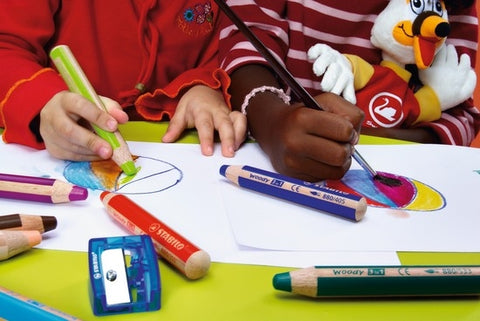
The best writing hold is the tripod grip using the index finger, thumb and with support from the middle finger from behind, as recommended by the National Handwriting Association.
To help children develop the tripod pencil grip :
- Using short, wide pencils, crayons or chalks encourage children to hold them between the thumb pad and index finger pad (like a bird beak). The pencil can then rest on the middle finger. The STABILO Woody - a coloured pencil, watercolour and wax crayon in one — is a great pencil to start children off with as its chunky shape is perfect for small hands to develop the right grip, especially for colouring.
- Placing a grip on the pencil will encourage a dynamic tripod grip (introduce use slowly). A great alternative to this is the STABILO EASY handwriting range which offers pens and pencils that have the grip zone integrated into them promoting the correct grip. Alternatively children could try using triangular pencils or putting a sticker or band around the pencil to show how to hold it near the tip.
This is just one of the way writing behaviour can be positively influenced. Here are some practical things that you can do to physically help and support children develop their writing skills.
Use of a suitable pen or pencil
- This will make writing and drawing easier, help them have a good posture and prevents their hand cramping. STABILO take time to work closely with ergonomists and fine motor specialists when developing our pens and pencils to make sure they meet the needs of the person using them.
Sitting position, lighting and clear working area
- A good sitting position at the table or desk can help children to be stable, comfortable and be able to concentrate and use their hands effectively.
Try to ensure that:
- Their feet are flat on the floor or on an appropriate support (e.g. foot block)
- Their pelvis is at the back of the seat and they are sitting up straight
- Their lower arms are relaxed on the desk and their hands are able to flow freely in all directions
- The work surface is high enough to stabilize the shoulders
- Their working area is well lit and not cluttered
- Sometime a slanted work surface can help if they are struggling to find a comfortable position.
Getting the pressure right
Sometimes children may struggle to write comfortably as they are applying too much or too little pressure. Too much and they will find writing hard work and may rip the paper they are working on. Too little and their marks and writing will not show up, both can cause frustration.
Tips to help reduce pressure:
- Play dough writing: flatten a piece onto a desk or table and use a pencil to write in it. For those that press too hard, the letters and lines come out all torn up so they get immediate feedback to lighten their pressure
- Writing on corrugated cardboard — encourage the child not to flatten the bumps on the cardboard
- Writing on tin foil backed with cardboard — encourage the child not to rip the foil when they write
Tips to help increase pressure:
- Use crayon rubbings - If too little pressure is used, the image will not come through clearly. After achieving the ‘perfect’ pressure, ask the child to maintain the same pressure with their eyes closed.
- Get the child to rub wax over a square of paper and then turn it over onto another piece of paper. Get the child to press hard onto the paper and draw shapes so the wax leaves marks on the other piece of paper.
- Try using a softer pencil, softer leads are classified as B and the harder are H.

